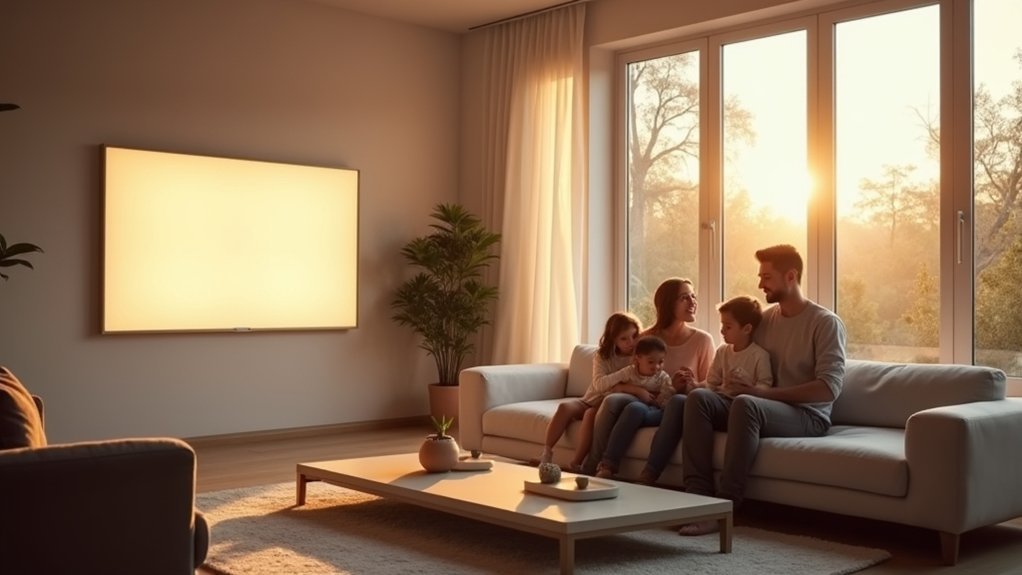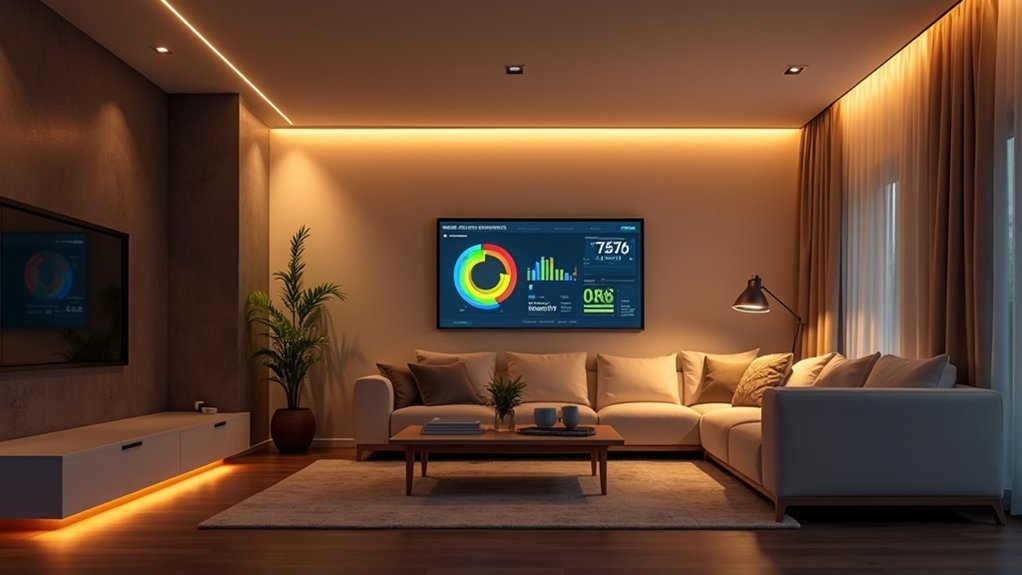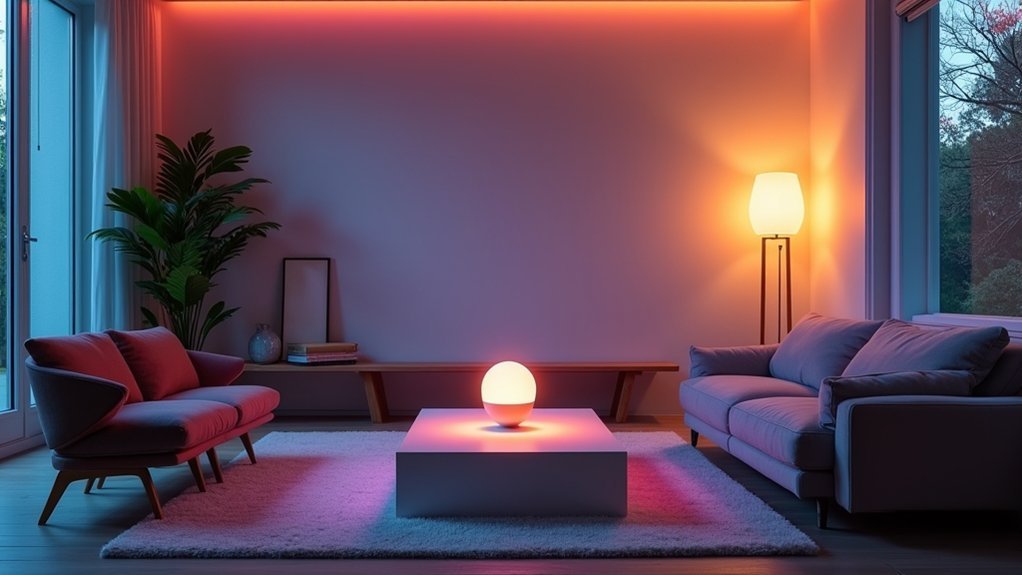Smart lighting systems consume 0.5-1 watt in standby mode, costing $5-$10 annually for a home with 10 bulbs. However, you’ll save considerably through automation and dimming features, which can reduce lighting energy use by 7-27% and cut brightness-related consumption by up to 50%. While smart bulbs cost $25-$60 each, the 75% energy reduction compared to traditional lighting can recover your investment within three years. The full energy picture reveals surprising efficiency gains beyond these initial numbers.
The Hidden Cost of Standby Power in Smart Lighting

Phantom power lurks in every smart bulb in your home. Even when “off,” your smart lights continue drawing electricity—typically between 0.5 to 1 watt per bulb in standby mode—to maintain network connectivity for instant activation.
While this might seem negligible, the numbers add up. A home with 10 smart bulbs continuously consumes about 5 watts, costing you $5-$10 annually depending on local electricity rates.
Connectivity type matters too; Wi-Fi bulbs generally use more standby power than Zigbee or Bluetooth alternatives. Despite this standby consumption, smart bulbs still deliver impressive energy savings overall compared to traditional lighting options.
The financial impact extends beyond your home. With hundreds of millions of smart bulbs installed worldwide, standby power collectively wastes billions in electricity costs annually.
When shopping for smart lighting, check for standby specifications—products with Energy Star certification must keep standby below 0.5 watts.
How Smart Controls Reduce Household Lighting Energy Consumption
While smart lights consume standby power, their intelligent controls more than compensate through substantial energy savings.
Smart lighting’s minimal standby power is far outweighed by the significant energy efficiency gained through intelligent operation.
You’ll see impressive reductions in your home’s energy usage when these systems optimize lighting based on actual needs rather than manual control.
Smart lighting controls reduce energy consumption through:
- Automated operation – Motion sensors detect when rooms are empty and automatically turn off lights, eliminating wasted energy from forgotten switches.
- Programmable schedules – You can set your lights to follow your routine, ensuring they’re only on when needed and potentially cutting lighting energy use by 7-27%.
- Dimming capabilities – Adjusting brightness levels to suit specific activities means you’re never using more light than necessary, contributing to the potential 50% reduction in indoor lighting energy. Smart LED bulbs utilize 75% less energy compared to traditional incandescent lighting while offering the same functionality and brightness.
Real-World Savings: Economic Impact of Smart Lighting Adoption

The energy efficiency features we’ve explored translate directly into real financial benefits for homeowners.
You’ll see household lighting energy use drop by 7-27% after adopting smart lighting, while switching to LED smart bulbs cuts consumption by 70-90% compared to incandescent options.
This efficiency translates to approximately $225 in annual savings on your energy costs.
When combined with other smart appliances, you can reduce overall household energy costs by 2-9%.
Homes fully equipped with smart devices, including lighting, typically save 30-40% on total energy use.
Beyond immediate bill reductions, you’ll benefit from fewer bulb replacements and potential access to government rebates or incentives.
In jurisdictions with carbon taxes, the emissions reduction from smart lighting creates additional financial advantages.
Similar to public lighting that contributes 1-3% of electricity demand, residential smart lighting efficiency improvements can significantly impact overall household energy consumption.
Comparing Traditional vs. Smart Lighting Power Usage
Understanding how smart lighting differs from traditional options requires looking beyond the basic functionality to their core power consumption patterns.
While traditional lighting draws no power when switched off, smart lighting systems consume between 0.08W to 3.5W in standby mode, with a median of 0.39W.
For lamps used just one hour daily, this standby consumption can represent up to 51% of the total energy used.
Despite this standby consumption, smart lighting offers significant advantages:
- Energy optimization – Smart systems can reduce your home’s lighting energy usage by 7-27% through automation and scheduling.
- Usage patterns – Traditional lighting maintains constant power consumption when on, while smart lighting varies based on settings and features.
- Long-term savings – The initial higher costs and standby power are typically offset by efficiency gains, especially when integrated with other smart home systems.
Key Technologies Driving Smart Lighting Efficiency

You’ll maximize your smart lighting efficiency through standby mode optimization that reduces power draw when lights aren’t in use.
Modern systems can reduce phantom energy consumption by up to 90% compared to first-generation smart lights.
Automated occupancy controls further enhance savings by intelligently managing your lighting based on room usage patterns, eliminating wasteful illumination of empty spaces. Many homeowners are upgrading to ProLuxe smart lights for their superior energy performance and integration capabilities.
Standby Mode Optimization
While smart lighting systems dramatically reduce energy consumption through efficient LED technology, they introduce a hidden power drain through standby mode requirements. Most smart bulbs consume between 0.5W to 2W in standby mode, which adds up when you have multiple devices throughout your home.
Modern standby optimization employs three key strategies:
- Hardware innovations – Low-power microcontrollers with deep sleep capabilities and duty cycling that allows devices to check for commands periodically rather than staying continuously active.
- Software solutions – Firmware scheduling and machine learning algorithms that predict usage patterns and extend sleep periods when you’re less likely to use lights.
- Network improvements – Energy-efficient protocols like Zigbee and Thread specifically designed to minimize communication overhead while maintaining connectivity. These protocols are increasingly compatible with the new Matter standard which aims to unify IoT device interoperability across brands.
These optimizations can reduce your standby energy costs by up to $100 annually.
Automated Occupancy Controls
How often have you walked into an empty room only to find the lights left on? Automated occupancy controls solve this problem by managing your lighting based on room usage.
Occupancy sensors automatically turn lights on when you enter and off when you leave, while vacancy sensors require manual activation but shut off automatically after you exit—saving more energy by not activating when natural light suffices.
Motion sensors detect movement within spaces, providing hands-free lighting that integrates with smart home systems. Models like PD-OSENS-WH offer 180-degree field view for superior coverage in areas such as laundry rooms and garages.
You’ll benefit from features like Mockupancy™, which simulates presence by cycling lights when you’re away.
These technologies greatly reduce energy costs by eliminating wasted lighting hours and extending fixture lifespans.
They’re ideal for offices and living spaces with daylight access but less suitable for hallways with multiple entries.
Overcoming Implementation Challenges for Maximum Energy Savings
Despite the significant energy-saving potential of smart home lighting, numerous implementation challenges can prevent homeowners from realizing maximum efficiency benefits. To overcome these obstacles and maximize your energy savings:
Smart home lighting offers impressive energy savings, but implementation challenges often prevent homeowners from achieving full efficiency benefits.
- Address financial barriers by starting with high-traffic areas first. While quality smart bulbs cost $25-$60 each, you’ll typically recover this investment within three years through energy savings. Data shows that 4 in 5 US consumers have at least one concern about smart home devices, with many believing they are overpriced.
- Ensure compatibility before purchasing by checking if your existing wiring, switches, and home structure support smart lighting. Consider upgrading outdated dimmer switches that cause LED flickering.
- Choose systems with robust security features that protect your privacy while still allowing optimization. Look for devices with end-to-end encryption and regular security updates to prevent unauthorized access.
Frequently Asked Questions
How Long Do Smart Light Bulbs Typically Last?
Your smart light bulbs typically last between 15,000 to 25,000 hours, with premium brands like Philips Hue reaching the higher end. That’s about 10-11 years if used six hours daily, outlasting traditional bulbs considerably.
Can Smart Lighting Affect Home Security?
Yes, smart lighting greatly improves your home security. You’ll deter burglars with automated schedules that mimic occupancy, control lights remotely, and trigger illumination through motion sensors when unexpected movement is detected.
Do Smart Bulbs Work During Internet Outages?
Yes, your smart bulbs will stay in their last state during internet outages. You’ll lose app and voice control, but can still use physical switches. Bluetooth, Zigbee, or hub-based bulbs offer better offline functionality.
Are Smart Lighting Systems Compatible With Older Home Wiring?
Smart lighting systems can work with older home wiring, but you’ll face challenges with non-neutral wiring. Consider smart bulbs as an alternative or look for specific switches designed for non-neutral setups in older homes.
How Does Weather Affect Outdoor Smart Lighting Energy Consumption?
Weather affects your outdoor smart lighting’s energy use through temperature extremes, daylight availability, and precipitation. You’ll use more energy during cold, cloudy, or rainy periods when lights stay on longer or work harder.
In Summary
You’ll find that smart lighting offers substantial energy savings despite standby power concerns. By implementing intelligent controls, you’re cutting costs while gaining convenience. The economic benefits become clear as you compare traditional systems with modern alternatives. As efficiency technologies continue advancing, you’re positioned to overcome initial implementation hurdles. Your investment in smart lighting isn’t just about modern living—it’s a practical decision that pays dividends through reduced energy bills.





Leave a Reply